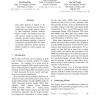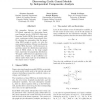613 search results - page 50 / 123 » Learning the Structure of Linear Latent Variable Models |
CEC
2009
IEEE
14 years 3 months ago
2009
IEEE
—Structure learning is a crucial component of a multivariate Estimation of Distribution algorithm. It is the part which determines the interactions between variables in the proba...
ICDM
2005
IEEE
14 years 2 months ago
2005
IEEE
The preference model introduced in this paper gives a natural framework and a principled solution for a broad class of supervised learning problems with structured predictions, su...
BMCBI
2010
13 years 9 months ago
2010
Background: Protein kinases play crucial roles in cell growth, differentiation, and apoptosis. Abnormal function of protein kinases can lead to many serious diseases, such as canc...
ACL
2003
13 years 10 months ago
2003
This paper presents a method to develop a class of variable memory Markov models that have higher memory capacity than traditional (uniform memory) Markov models. The structure of...
UAI
2008
13 years 10 months ago
2008
We generalize Shimizu et al's (2006) ICA-based approach for discovering linear non-Gaussian acyclic (LiNGAM) Structural Equation Models (SEMs) from causally sufficient, conti...


